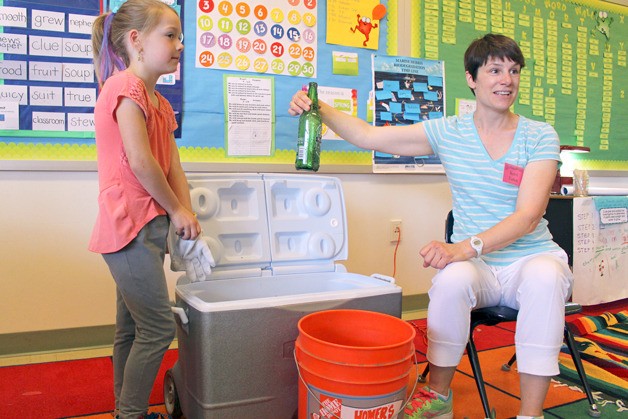Kerri Totten hauled a cooler to her son’s second grade class at Broad View Elementary, and it was filled with everything she found at Windjammer Park.
Shells. A stinky barnacle. Some twine. A beer bottle. Candy wrappers.
She called students one at a time to pluck out an item. Then everyone guessed how long it would take to break down in the environment.
That candy wrapper takes up to 20 years to disappear.
“Do candy wrappers belong at the beach?” she asked.
“NOOOOOO!” they chorused back.
Totten, a marine biologist, has made an impression on the students. Several of them were expected to attend the Oak Harbor City Council meeting Tuesday to ask city leaders to put up a few educational signs about littering at the park.
The presentation comes at the same time the mayor is expected to sign a proclamation celebrating Earth Day, which is April 22.
It’s perhaps a small thing but one that made the students feel empowered.
Tiana Myles, 8, said she likes going to City Beach to ride her bike and swim. It’s a pretty place, she said.
She doesn’t understand why people drop their soda cans and beer bottles on the beach.
“Pick up your trash!” she said.
She plans to pick up hers. So does her classmate, Xavier Ochoa, 9. Sometimes he and his friends pick up other people’s garbage too.
“It makes me sad,” he said. “People should pick up their trash.”

The children are already exposed to a year-long science curriculum, said teacher Jill Ashley-Chase. Having a parent who is a marine biologist was icing on the cake.
“We relate everything we learn to our environment and how it impacts the earth,” she said. “The children are learning and putting into practice principles concerning being good stewards of our planet.”
Totten wrote to city parks director Hank Nydam on behalf of the students and sent some of their drawings of Windjammer Park.
It’s hard to resist second graders.
“I like their enthusiasm,” he said.
Nydam was receptive to the idea. He had two of the marine debris biodegradation signs made and plans to install them at the park — one on the windmill and another at the west end of the park.
“So often they do the classroom lesson and nothing happens,” he said. “They can see something happen in the real world.”

